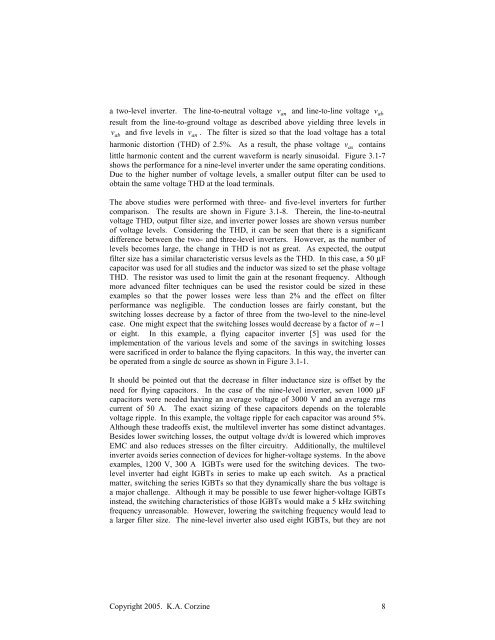Operation and Design of Multilevel Inverters Dr ... - MotorLab.com
Operation and Design of Multilevel Inverters Dr ... - MotorLab.com
Operation and Design of Multilevel Inverters Dr ... - MotorLab.com
Create successful ePaper yourself
Turn your PDF publications into a flip-book with our unique Google optimized e-Paper software.
a two-level inverter. The line-to-neutral voltage v an <strong>and</strong> line-to-line voltage v ab<br />
result from the line-to-ground voltage as described above yielding three levels in<br />
v ab <strong>and</strong> five levels in v an . The filter is sized so that the load voltage has a total<br />
harmonic distortion (THD) <strong>of</strong> 2.5%. As a result, the phase voltage v as contains<br />
little harmonic content <strong>and</strong> the current waveform is nearly sinusoidal. Figure 3.1-7<br />
shows the performance for a nine-level inverter under the same operating conditions.<br />
Due to the higher number <strong>of</strong> voltage levels, a smaller output filter can be used to<br />
obtain the same voltage THD at the load terminals.<br />
The above studies were performed with three- <strong>and</strong> five-level inverters for further<br />
<strong>com</strong>parison. The results are shown in Figure 3.1-8. Therein, the line-to-neutral<br />
voltage THD, output filter size, <strong>and</strong> inverter power losses are shown versus number<br />
<strong>of</strong> voltage levels. Considering the THD, it can be seen that there is a significant<br />
difference between the two- <strong>and</strong> three-level inverters. However, as the number <strong>of</strong><br />
levels be<strong>com</strong>es large, the change in THD is not as great. As expected, the output<br />
filter size has a similar characteristic versus levels as the THD. In this case, a 50 µF<br />
capacitor was used for all studies <strong>and</strong> the inductor was sized to set the phase voltage<br />
THD. The resistor was used to limit the gain at the resonant frequency. Although<br />
more advanced filter techniques can be used the resistor could be sized in these<br />
examples so that the power losses were less than 2% <strong>and</strong> the effect on filter<br />
performance was negligible. The conduction losses are fairly constant, but the<br />
switching losses decrease by a factor <strong>of</strong> three from the two-level to the nine-level<br />
case. One might expect that the switching losses would decrease by a factor <strong>of</strong> n −1<br />
or eight. In this example, a flying capacitor inverter [5] was used for the<br />
implementation <strong>of</strong> the various levels <strong>and</strong> some <strong>of</strong> the savings in switching losses<br />
were sacrificed in order to balance the flying capacitors. In this way, the inverter can<br />
be operated from a single dc source as shown in Figure 3.1-1.<br />
It should be pointed out that the decrease in filter inductance size is <strong>of</strong>fset by the<br />
need for flying capacitors. In the case <strong>of</strong> the nine-level inverter, seven 1000 µF<br />
capacitors were needed having an average voltage <strong>of</strong> 3000 V <strong>and</strong> an average rms<br />
current <strong>of</strong> 50 A. The exact sizing <strong>of</strong> these capacitors depends on the tolerable<br />
voltage ripple. In this example, the voltage ripple for each capacitor was around 5%.<br />
Although these trade<strong>of</strong>fs exist, the multilevel inverter has some distinct advantages.<br />
Besides lower switching losses, the output voltage dv/dt is lowered which improves<br />
EMC <strong>and</strong> also reduces stresses on the filter circuitry. Additionally, the multilevel<br />
inverter avoids series connection <strong>of</strong> devices for higher-voltage systems. In the above<br />
examples, 1200 V, 300 A IGBTs were used for the switching devices. The twolevel<br />
inverter had eight IGBTs in series to make up each switch. As a practical<br />
matter, switching the series IGBTs so that they dynamically share the bus voltage is<br />
a major challenge. Although it may be possible to use fewer higher-voltage IGBTs<br />
instead, the switching characteristics <strong>of</strong> those IGBTs would make a 5 kHz switching<br />
frequency unreasonable. However, lowering the switching frequency would lead to<br />
a larger filter size. The nine-level inverter also used eight IGBTs, but they are not<br />
Copyright 2005. K.A. Corzine 8


